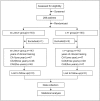Modified long-axis in-plane ultrasound technique versus conventional palpation technique for radial arterial cannulation: A prospective randomized controlled trial
- PMID: 31914094
- PMCID: PMC6959944
- DOI: 10.1097/MD.0000000000018747
Modified long-axis in-plane ultrasound technique versus conventional palpation technique for radial arterial cannulation: A prospective randomized controlled trial
Abstract
Background: A low first-pass success rate of radial artery cannulation was obtained when using the conventional palpation technique (C-PT) or conventional ultrasound-guided techniques, we; therefore, evaluate the effect of a modified long-axis in-plane ultrasound technique (M-LAINUT) in guiding radial artery cannulation in adults.
Methods: We conducted a prospective, randomized and controlled clinical trial of 288 patients undergoing radial artery cannulation. Patients were randomized 1:1 to M-LAINUT or C-PT group at Fujian Medical University Union Hospital between 2017 and 2018. Radial artery cannulation was performed by 3 anesthesiologists with different experience. The outcome was the first and total radial artery cannulation success rates, the number of attempts and the cannulation time, and incidence of complications.
Results: Two hundred eighty-five patients were statistically analyzed. The success rate of first attempt was 91.6% in the M-LAINUT group (n = 143) and 57.7% in the C-PT group (n = 142; P < .001) (odds ratio, 7.9; 95% confidence interval, 4.0-15.7). The total success rate (≤5 minutes and ≤3 attempts) in the M-LAINUT group was 97.9%, compared to 84.5% in the palpation group (P < .001) (odds ratio, 8.5; 95% confidence interval, 2.5-29.2). The total cannulation time was shorter and the number of attempts was fewer in the M-LAINUT group than that in the C-PT group (P < .05). The incidence of hematoma in the C-PT group was 19.7%, which was significantly higher than the 2.8% in the M-LAINUT group (P < .001).
Conclusions: Modified long-axis in-plane ultrasound-guided radial artery cannulation can increase the first and total radial artery cannulation success rates, reduce the number of attempts, and shorten the total cannulation time in adults.
Conflict of interest statement
The authors have no conflicts of interest to disclose.
Figures



References
-
- Seto AH, Roberts JS, Abu-Fadel MS, et al. Real-time ultrasound guidance facilitates transradial access: RAUST (Radial Artery access with Ultrasound Trial). JACC Cardiovasc Interv 2015;8:283–91. - PubMed
-
- Jyoti B, Rohit D, Sonali K, et al. Comparison of conventional and ultrasound guided techniques of radial artery cannulation in different haemodynamic subsets: a randomised controlled study. Intensive Care Med 2017;43:140–1. - PubMed
Publication types
MeSH terms
LinkOut - more resources
Full Text Sources

